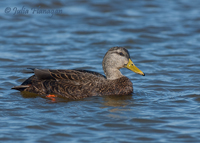
 |
Photos
© Julia Flanagan |
American Black Duck The American Black Duck is a large dabbling duck. These birds feed by dabbling in shallow water, and grazing on land. They mainly eat plants, but also some mollusks and aquatic insects. The eggs are a greenish buff color. They lay from 6-14 eggs that hatch in an average of 30 days. Some conservationists consider the hybridization and competition with the Mallard an additional source of concern. It should be noted that the hybridization itself is not the major problem as natural selection will see to that the best-adapted individuals still have the most offspring. However, the reduced viability of female hybrids may cause many broods to fail in the long run as the offspring die before reproducing themselves. While this is not a problem in the plentiful mallard, it will place an additional strain on the American Black Duck's population. |
Home | Upcoming Events | About Us | Resource Issues | News | Local Contacts Maps | Photos | Publications | Youth Education | FAQ's | Links | Membership |





